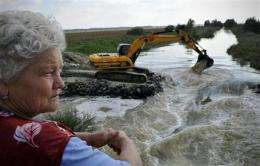Toxicity of Hungary's red sludge flow drops

(AP) -- The concentration of toxic heavy metals where Hungary's massive red sludge spill entered the Danube has dropped to the level allowed in drinking water, authorities said Friday, easing fears that Europe's second longest river would be significantly polluted.
Monday's reservoir break at an alumina plant dumped up to 700,000 cubic meters (184 million gallons) of sludge onto three villages, government officials said, not much less in a few hours than the 200 million gallons the blown-out BP oil well gushed into the Gulf of Mexico over several months.
The red sludge devastated creeks and rivers near the spill site and entered the Danube on Thursday, moving downstream toward Croatia, Serbia and Romania. Monitors were taking samples every few hours Friday to measure damage from the spill but the sheer volume of water in the mighty Danube appeared to be blunting the red sludge's immediate impact.
Test results released by Hungary's disaster agency show the pH level of the water where the slurry entered the Danube was under 9 - well below the 13.5 measured earlier in local waterways near the site of the catastrophe. That is diluted enough to prevent any biological damage, Interior Minister Sandor Pinter said.
Despite the apparent good news, the risk of pervasive and lasting environmental damage remained at the site of the spill, with Greenpeace presenting laboratory tests that it said showed high concentrations of heavy metals in the sludge.
Also Friday, the disaster's confirmed death toll rose from four to seven. An 81-year-old man died from injuries sustained in the torrent and two bodies were found on the outskirts of Devecser. The unidentified victims were likely two of three Kolontar residents still missing, rescue agency spokesman Tibor Dobson said.
Dobson gave no further details, but the location of the bodies suggested they were swept over 3 kilometers (2 miles) by the torrent.
Elsewhere, officials in Croatia said analysis of the Danube's water at Batina, where the river enters Croatia from Hungary, showed "no difference from its usual quality."
Samples would be taken twice a day from Saturday, said the Croatian Center for Prevention and Rescue. As a precaution, the town of Vukovar stopped using water from the Danube on Friday, relying instead on underground wells.
Hungarian Prime Minister Viktor Orban said the threat to the Danube had been eliminated, and the International Commission for the Protection of the Danube, a Vienna-based group that monitors the river and its tributaries, agreed.
"We managed to take control of the situation in time," the state MTI news agency quoted Orban as saying.
"The consequences do not seem to be that dramatic," said Philip Weller, head of the Danube commission, told The Associated Press.
In recent decades, the Danube has benefited from a massive cleanup effort involving all 10 countries that share the river. Marine life are again healthy, cormorants have returned to many stretches and the Danube delta emptying into the Black Sea is one of Europe's greatest homes for unique wildlife.
At the site of the catastrophe, the environmental devastation was apparent. Red sludge samples taken Tuesday, a day after the spill, contained "surprisingly high" levels of arsenic and mercury, Greenpeace told reporters in Vienna on Friday. The analysis suggested that roughly 50 tons of arsenic, 300 tons of chrome and half a ton of mercury was unleashed by the spill, Greenpeace officials said.
They said the detected arsenic concentration was twice the amount normally found in so-called red mud, a waste product in aluminum production. Analysis of water in a canal near the spill also found arsenic levels 25 times the limit for drinking water, Greenpeace said.
With rain giving way to dry, warmer weather, the caustic mud was increasingly turning to airborne dust, which can cause respiratory problems, said Zoltan Illes, Hungary's environmental chief. Emergency officials urged residents near the toxic flood area to wear face masks.
The warnings conflicted with the view of the prestigious Hungarian Academy of Sciences, which reiterated Friday that the red sludge remained hazardous due to its caustic alkalinity but its heavy metal concentrations were not considered dangerous for the environment.
"The academy can say whatever it wants," fumed Barbara Szalai Szita, who lives in Devecser, one of the hardest-hit villages. "All I know is that if I spend 30 minutes outside I get a foul taste in my mouth and my tongue feels strange."
It is still not known what caused a section of the reservoir to collapse.
However, meteorologists at AccuWeather.com noted that spring and summer rains across eastern Europe were more than 200 percent above normal and said the walls holding back the sludge may have been weakened by the rain.
MAL Rt., the Hungarian Aluminum Production and Trade Company that owns the Ajkai Timfoldgyar plant where the spill occurred has rejected criticism it should have taken more precautions at the reservoir.
Hungarian police have confiscated documents from the company, and the National Investigation Office was looking into whether on-the-job carelessness was a factor in the disaster.
Pinter, the interior minister, said Friday that authorities had begun questioning people in the case and were looking for witnesses who could provide information about the reservoir's operations and maintenance work.
Pinter also told reporters that inspections of all of Hungary's red sludge reservoirs would be carried out, focusing not only on environmental aspects, but especially on the gigantic containers' structural issues.
There are red sludge storage sites at several other locations in western Hungary, holding at least 30 million cubic meters (1 billion cubic feet) of the material.
More than 150 victims were treated at hospitals and around a dozen are still in serious condition.
©2010 The Associated Press. All rights reserved. This material may not be published, broadcast, rewritten or redistributed.



















